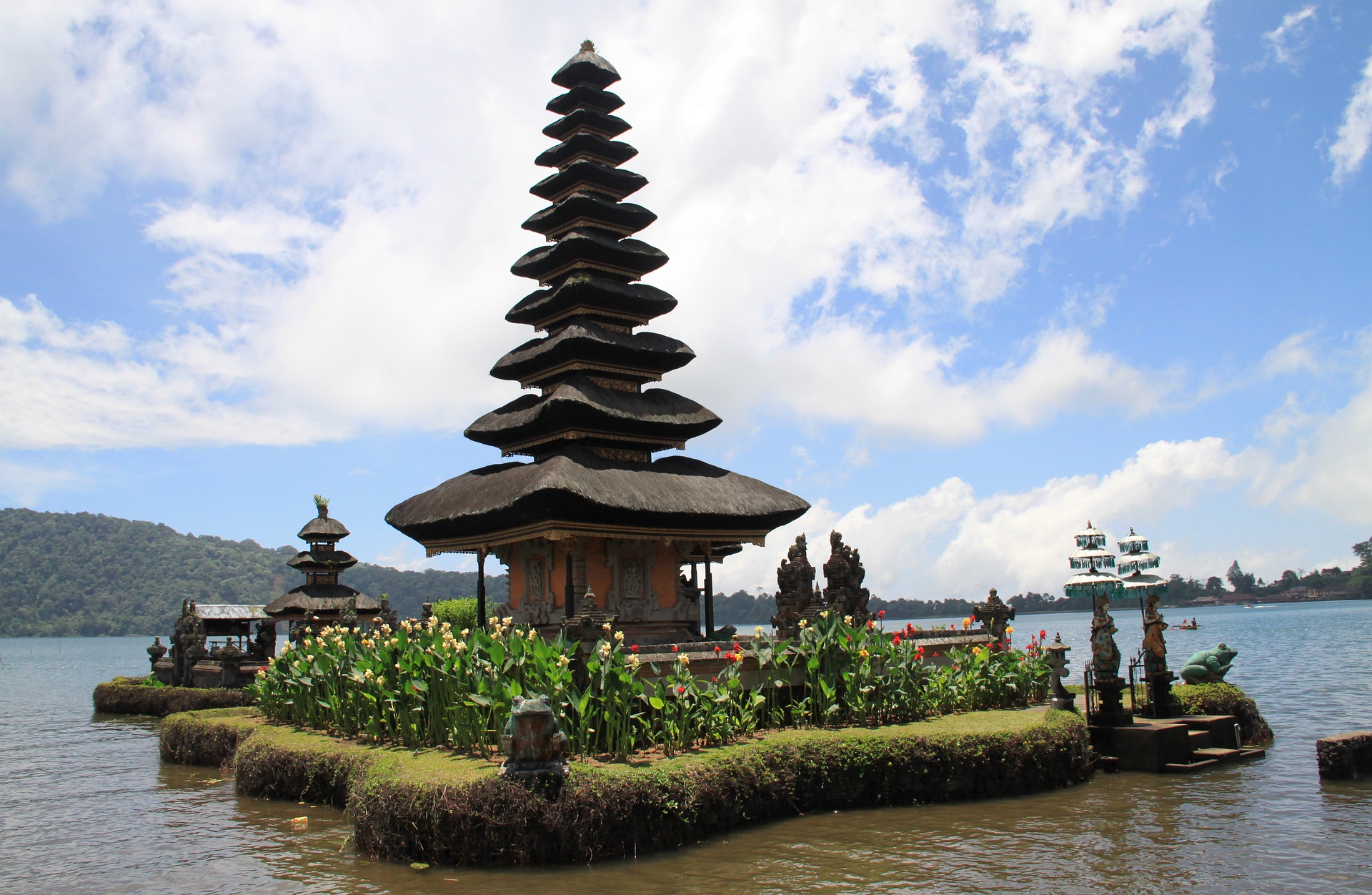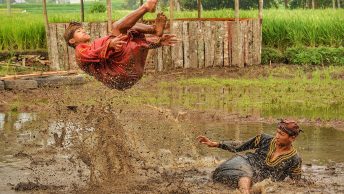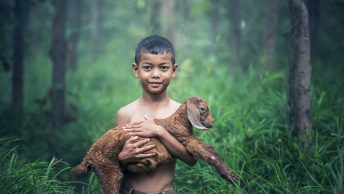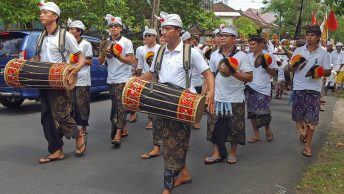Bali is just east of Java, only separated from Java by the narrow Bali Strait. On the east side is the island of Lombok.
Area is 5,623 square kilometers, the island is 145 kilometers long and 80 kilometers wide. The provincial capital is called Denpasar and is located in the south of Bali. The second largest city is called Singaraja and is located on the north side. Bali has several high volcanoes which, according to ancient beliefs, are the home of the gods. The largest is Gunung Agung (“Exalted Mountain”) which is 3,142 meters high. The volcano considered by the Balinese as the center of the universe.
At the foot of the mountain is the main temple of Besakih. The volcano’s last eruption was in 1963, when approximately 2,000 people lost their lives. To the south, the mountains slope down towards a large, lower-lying plain, where the volcanic soil is very fertile and the climate suitable for agriculture. The northern part of Bali, Buleleng, consists mainly of mountainous terrain, with a narrow inhabited strip along the coast. West Bali is not suitable for agriculture compared to south Bali and is considerably less populated.
Map of Bali
Climate
It is precisely the high mountains that are the reason why Bali is so fertile by contributing to the rainfall that regularly waters the rice terraces, the volcanic ash is also very well suited for agriculture. There are mainly two seasons here, the rainy season lasts roughly from November to March, and the best time to visit is between May and August.
Flora and fauna
Bali consists largely of cultural landscape with few remaining wilderness areas. In the western part is the Bali Barat National Park, which can offer a rich animal and plant life. The Balinese tiger that once roamed these forests has unfortunately long been extinct. Also on the slopes of the volcano Gunung Batukau, untouched rainforest still grows.
People and religion
The number of inhabitants is approximately 3 million, mainly of Indonesian origin. The majority of the population, approximately 95%, are Balinese Hindus. Like all other religions in Indonesia, this one is strongly flavored with old traditional religions from the area. This helps to make the Balinese culture so unique and colorful.
They worship the same gods as the Indians, but also have many of their own gods, spirits and other figures who play an almost equally large role in their everyday life. Bali has a traditional caste system like in India, but no work areas are based on caste, except for the Brahman priests. More than 90% belong to the common Sudra caste. Today, you only see the importance of the different castes in language, religious roles and rituals. The Balinese language is very different from Indonesian, and reflects the caste system. Traditionally, the language was divided into five forms. Today, three different forms are used; Low Balinese (Ia), Middle Balinese (Ipun) and High Balinese (Ida). The latter is preferably used when speaking to religious superiors.
Economy
The main sources of income are tourism, agriculture, crafts and textiles. Bali is economically and culturally one of the most important islands in Indonesia. Rice, sugar cane, coffee, tobacco, fruit and vegetables are grown here. Everywhere there are rice terraces that are built as part of the terrain. Watered by artificial canals. The fertile soil with its rich crops has also contributed to the fact that the Balinese have had the strength and time to develop their distinctive culture. The craftsmen here are well known for their skill in wood carving. They are also skilled gold and silversmiths. The culture with its traditional dances, gamelan music, ceremonies and beautiful temples draws millions of tourists here every year.
History
Bali has been inhabited since prehistoric times, but the oldest objects that have been found are stone tools and potsherds from around 3,000 years ago. Hinduism was probably brought to Bali by Indian traders already long before the year 1000, but the oldest inscriptions, written on stone, are from the 9th century and not much is known about the time before this.
The influence of the Hindus on Java started with King Airlangga who ruled East Java from 1019 to 1042. He was the son of the Balinese king Udayana and his Javanese queen Guna Pria Dharma Patni. Airlangga married a Javanese princess and moved to Java. When Airlangga was 16, his father-in-law Dharmawangsa lost his throne and his life. Airlangga had to flee to West Java. After a few years in hiding, he returned and managed to conquer the throne his father-in-law had lost. Airlangga became one of Java’s most powerful kings.
This helped establish a strong connection between Bali and Java. One of the best examples of this is the monuments in Gunung Kawi from this period. Clearly influenced by Javanese culture. In 1284, the Javanese king Kertanagara of the Singasari dynasty conquered Bali. But eight years later he was assassinated and his kingdom collapsed. His son later established Majapahit. In the vacuum that arose, the Pejeng dynasty in Bali (see Bedugul) grew into a powerful kingdom.
The Pejeng king Dalem Bedulu was finally defeated by the armies of the mythical and powerful Majapahit minister Gajah Mada in 1343, and Bali was again subject to Java’s influence. Bali’s capital was added to Gelgel near today’s Semarapura, formerly called Klungkung. This became the base of the “King of Bali” (or “Dewa Agung” meaning great god) for two centuries. Most of Bali’s royal family is descended from the royal line from Klungkung. In the 15th century, the Majapahit (see Java) empire had to give up to the Muslim Demak dynasty. Java’s Hindu aristocracy, soldiers, artists and artisans therefore fled to Bali.
The Pejeng king Dalem Bedulu was finally defeated by the armies of the mythical and powerful Majapahit minister Gajah Mada in 1343, and Bali was again subject to Java’s influence. Bali’s capital was added to Gelgel near today’s Semarapura, formerly called Klungkung. This became the base of the “King of Bali” (or “Dewa Agung” meaning great god) for two centuries. Most of Bali’s royal family is descended from the royal line from Klungkung. In the 15th century, the Majapahit (see Java) empire had to give up to the Muslim Demak dynasty. Java’s Hindu aristocracy, soldiers, artists and artisans therefore fled to Bali.
This led the island into a cultural golden age where art and culture flourished. Bali became independent and united under one ruler. The god king Batu Renggong also conquered Lombok, Sumbawa and parts of East Java. Batu Renggong had nine large temples built, of which the Balinese “mother temple”, Pura Besakih, was the central one. The Balinese calendar with rules for their complicated rituals was also created at this time. These rules are followed to this day. After Batu Renggong, Bali was divided between several kings (raja’s), a system that lasted for 300 years and led to several wars and much power struggle on the island.
Due to the Balinese’s traditional fear of the sea where there are many dark and evil forces that reside, and strangers (does not apply today), the island was practically isolated from around 1600 to 1900. Much of the unique dance, music and art we find in Bali today was developed and refined during this period out of consideration for the island’s countless gods (and kings).
Colonialisation
The first contact with Europeans occurred in 1597 when three Dutch ships made landfall near Kuta. Some of the crew were reportedly so captivated by this then-unknown island that they refused to leave again. This happened while Balinese art and culture was at its height. But luckily the Dutch were interested in goods and gold, not culture. It therefore took a long time before they returned. In 1846, Dutch forces were landed in North Bali and annexed Buleleng in 1848. They also tried to defeat the powerful Gelgel in 1846, but had to lose. In 1894, the Dutch supported the Sasaks of Lombok in a rebellion against their Balinese king. Thus the king had lost both North Bali and Lombok.
A shipwreck off Sanur in 1904. Where the ship was looted by local fishermen and the king of Badung refused to pay compensation, the Dutch provided the necessary pretext for a landing in Sanur in 1906. Badung (southern Bali) soon had to give up. This was too humiliating for the kings and their court. They therefore decided on a more dignified death by committing collective suicide, puputan. Dressed in white and armed only with knives, they headed straight for the Dutchmen’s guns. Almost 4,000 people were killed in the puputan. This was followed by Tabanan, where the king also committed suicide.
The kingdoms of Karangasem and Gianyar had already capitulated to the Dutch and were allowed to retain some of their rights. Other regions fell in turn. The last kingdom to be defeated was Klungkung, where the Dutch were again subjected to a puputan. However, their rule over Bali was short-lived when the island was occupied by Japan during the Second World War. After the war, the Dutch tried to take back Indonesia and Bali. At Marga on 20 November 1946, an entire resistance group lost their lives. Their leader was called Ngurah Rai, he has had Bali’s international airport named after him. In 1950, the island became part of the Republic of Indonesia.
Art and culture
Many people seem to believe that tourism has destroyed “paradise”. The fact is that dance, art and culture abound like never before. The Balinese traditionally have no separate word for art. This was something you just did as part of everyday life. Preferably for religious reasons. Today, this has completely changed with art galleries and craftsmen on every corner. Much of what is made is cheap souvenirs, but if you look a little more, you can find articles of very good quality. As a tourist, you will quickly notice the diligence that is put into the daily offerings and during larger ceremonies in one of the thousands of temples on the island.
A traditional Balinese house may consist of a high wall with several different bales inside. Bale is a rectangular pavilion with a sloping roof and open walls, in each village there is a larger bale banjar where the population can meet, discuss and perform dance and gamelan music. Many restaurants and hotel receptions are often built like a bale banjar.
The best architectural art is reserved for the temples. Where the most important are very richly decorated with sculptures and carvings. Each household has its own family temple. And every village has at least three temples, each with its own function; pura puseh is in honor of the founders of the village, pura desa for the spirits that protect the village, pura dalem is the temple of the dead. The cemetery is also located here. Other temples are so important that they belong to the whole island, such as Pura Besakih. In the most important temples, the altars will include the characteristic meru. A kind of pagoda with several roofs. The most important ones have 11 such roofs, the number is almost always an odd number. Scattered around the island there are also several more or less well-kept palaces. In memory of the mighty kings who once ruled here. Descendants often still live there. Large statues can be found everywhere, often made to protect road travelers and the population in general.
Generally
Of course, Bali also has its tiring mass tourism with all that brings with it tired salespeople and overcrowded hotels and beaches. But if you manage to look past this, you find a jewel that you keep wanting to come back to. By all means, take a few trips away from the big tourist centers and see the real, traditional Bali.
Do not be afraid to bring small children here, the Balinese treat children as little gods, the first time after a child is born, for example, it must always be carried around and not touch the earth in order to be as clean and close to the gods as possible. There are always new places and customs to discover here, no matter how long you stay here. It is said that what is the custom in one village is the exception in another. The fact that Bali also has fantastic nature makes this island one of the most exotic destinations the world has to offer.
Photo credit: https://pixabay.com/photos/travel-water-lake-pagoda-sky-3239795/







